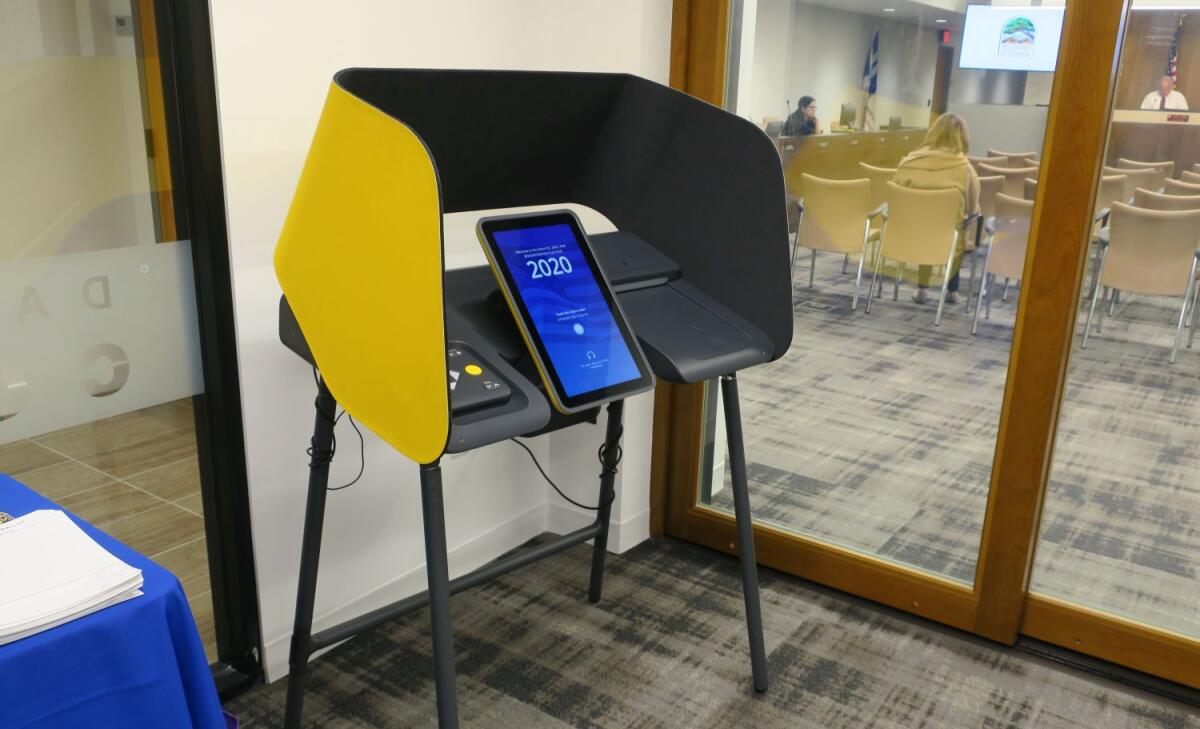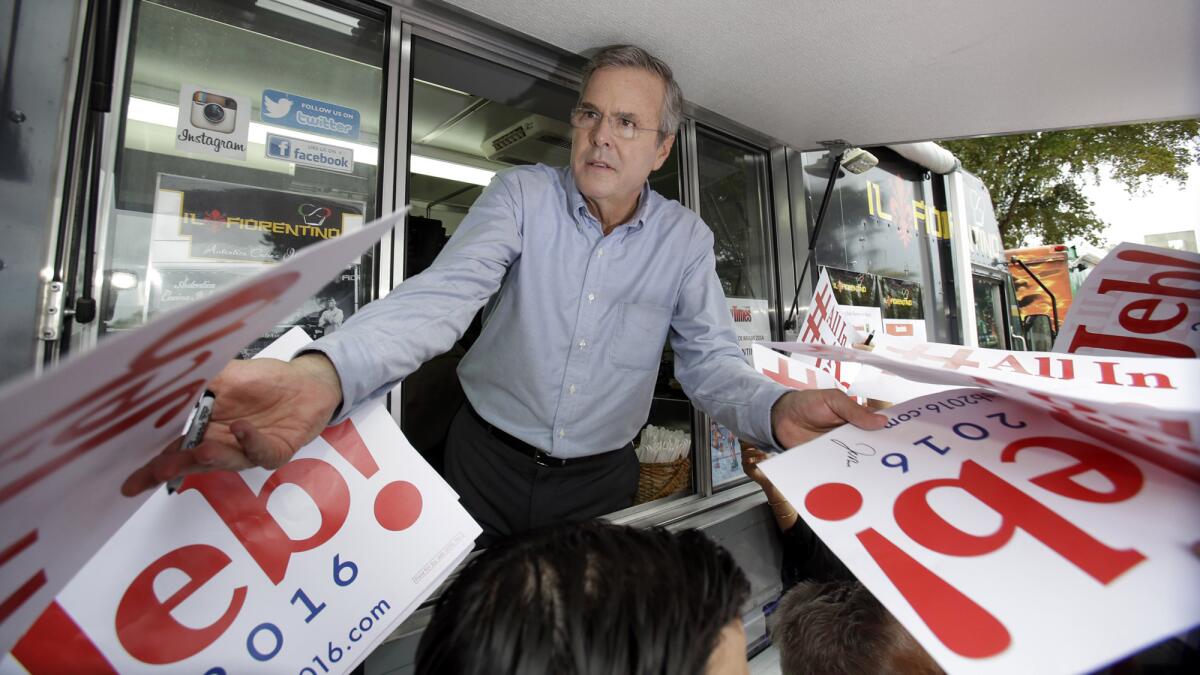Newsletter: How the newspaper endorsement sausage gets made

- Share via
Good morning, and welcome to the Essential California newsletter. It’s Wednesday, Feb. 26, and I’m writing from Los Angeles.
Sign up for Essential California
The most important California stories and recommendations in your inbox every morning.
You may occasionally receive promotional content from the Los Angeles Times.
The March 3 election is less than a week away, and voting in California is already underway. As Californians prepare to head to the ballot box, many will turn to the editorial pages of their local paper for a list of endorsements.
You may agree or disagree with an editorial board’s reasoning and ultimate choices. But in any reputable paper, you’ll find a well-researched starting point for making your own decisions.
The nine-member Los Angeles Times editorial board endorses selectively, which means it picks and chooses the races in which it makes recommendations. This year’s recommendations for the local and state elections include multiple L.A. City Council and L.A. County Board of Supervisor seats, the L.A. district attorney’s race, school board members and Superior Court judicial seats, among other things.
[See the complete list of L.A. Times endorsements in the March 3 California primary]
But how, exactly, does The Times’ editorial board decide on those endorsements? I sat down with Jon Healey, our deputy editorial page editor, to talk it through.
The first thing to know is that the editorial board operates independently from the newsroom.
Let’s do that one more time for the readers in the cheap seats.
As a newsroom staffer, I had nothing to do with these endorsements. None of the impartial journalists in our newsroom did. Yes, we all work in the same building and say hi to each other in the hallways. But the editorial board is “almost seen as a wholly separate environment” from the rest of the paper, according to Jon.
So, how does the board itself function? Jon described it as “a mini-newsroom” that also serves as “the voice of the institution.” That’s a particularly apt explanation, because it highlights another aspect of the editorial board that many readers may not fully understand — the fact that they also operate as a newsroom, with their work informed by extensive reporting and research.
Take for example, these endorsements for the March 3 California primary. The board didn’t just sit around in a smoke-filled conference room and then deliver its pronouncements fully formed, like Athena from Zeus’ head. They reported them out. (And there is no smoking in the building, or within a few hundred feet of it.)
The process actually starts about two months before ballots are mailed, with the board inviting candidates to come in for interviews. Occasionally, a candidate will refuse to sit down with the board, but they’re all invited. The board met with well over 100 candidates for this slate of endorsements
But those interviews are just the start of the reporting process. “For example, on a City Council race, we’ll talk to neighborhood council people, businesspeople, NGOs [non-governmental organizations], community activists — everybody that we can think of who has an eye on how their government has functioned and what the challenges are in their district,” Jon said, estimating that 20 or 30 people might be interviewed for a single City Council race.
In all of these races, at least two people will be assigned to research the individual candidates. Some of the pair’s reporting might be done separately, but they talk frequently during the process to compare notes and concerns. They’ll eventually come up with their recommendation, which they then present and argue for before the broader board. Sometimes, the discussion is quick and easy. And sometimes the questions will continue over the course of several meetings.
When I needled Jon to nail down a description of where the board’s choices fall on the political spectrum, it became clear that I was still missing a fundamental part of how my editorial page colleagues do their jobs.
“It’s not ideological,” he explained. Reporting, and not political doctrine, is what drives their decisions. They approach each race the same way any journalist would approach a story they’re trying to get to the bottom of — gather all the facts, talk to everyone you can, try to poke holes in what you think you know, ask some more questions and then make some more calls. They’re just creating a very different end product from the rest of the newsroom.
“Some readers think that we’re just a group of loony lefties, and some readers think that we are closet Republicans,” he added. “We are not a board that is single-minded about anything.”
Here are the editorial board endorsements from a few other papers around the state:
And now, here’s what’s happening across California:
A changing of the Bobs in Burbank: In a stunning move that marks the end of an era for one of the entertainment industry’s great corporate success stories, Bob Iger stepped down as chief executive of Walt Disney Co. on Tuesday after 15 years in the job. Bob Chapek, a 27-year Disney veteran who most recently led the company’s massively important parks and consumer products business, was named Iger’s successor, effective immediately. Disney’s CEO succession plan has been the subject of speculation for years, but the timing of the announcement surprised many in the industry because Iger still has 22 months left on his contract. Los Angeles Times
San Francisco Mayor London Breed has declared a local emergency amid coronavirus fears. Breed made the announcement after the Centers for Disease Control and Prevention’s warning that the virus is likely to continue to spread. While three people have been treated for COVID-19 at San Francisco hospitals, there have been no confirmed cases of the illness in the city. Los Angeles Times
L.A. STORIES
One of L.A.’s most recognizable chefs was hit by a car last week while walking on Pico Boulevard. Walter Manzke (of Republique, Petty Cash Taqueria and Sari Sari Store) suffered multiple serious injuries, including collapsed lungs and broken ribs. Eater LA
Mazzy Star co-founder David Roback has died at 61. The reclusive musician helped define the sound of the city’s 1980s and ’90s rock underground. Los Angeles Times
Enjoying this newsletter?
Subscribe to the Los Angeles Times.
IMMIGRATION AND THE BORDER
The Supreme Court’s conservative majority on Tuesday shielded a U.S. border agent from being sued for shooting and killing an unarmed teenager standing on the Mexican side of the Rio Grande. Los Angeles Times
POLITICS AND GOVERNMENT
Five takeaways from the South Carolina Democratic debate, including Mike Bloomberg mildly improving on his widely panned debate performance last week in Las Vegas, and Elizabeth Warren yet again tearing into the former New York City mayor. Los Angeles Times
Where does all the campaign swag go after a candidate drops out? Some items are reused in future campaigns. Others are thrown away. And some resurface in Kenya. New York Times

New California school vaccine rules have left nurses, doctors and parents confused: A pair of hotly debated new California laws limiting which schoolchildren can skip vaccines appears stuck in bureaucratic limbo, the result of uncertainty over how to interpret last-minute changes made before the legislation was signed last year by Gov. Gavin Newsom. Los Angeles Times
See also: Anti-vaccine protesters received assurances from First Partner Jennifer Siebel Newsom during an impromptu chat. In a video taken Monday, Siebel Newsom is seen talking with the protesters about the vaccine laws signed by Gov. Newsom last year before she asks that they not post the video online. Los Angeles Times
California Lottery officials shortchanged schools by millions, according to a scathing state audit. Los Angeles Times
CRIME AND COURTS
The heir to a Hot Pockets fortune was sentenced to five months in prison for her role in the college admissions scandal. Los Angeles Times
CALIFORNIA CULTURE
Where are the cheapest apartments to rent in California? The San Joaquin Valley. Fresno Bee
In what some are calling the “Curry House Massacre” or “Brown Wedding,” Curry House, the popular Japanese American chain, abruptly shut all of its restaurants Monday, including nine locations in Southern California. Los Angeles Times
Of course Silicon Valley prenups include social media guidelines. “Family law specialists in San Francisco and Silicon Valley say millennials in tech are seeking prenups at much higher rates than their elders did — and that they’re using them to prevent potential post-marital problems that their predecessors never had to consider.” Protocol
In 1969, residents of Southern Humboldt were so irked by the hippie influx that more than 100 signed a petition, asking the county supervisors for help combating the “mass infiltration” of hippies into their Northern California community. Redheaded Blackbelt
CALIFORNIA ALMANAC
Los Angeles: sunny, 79. San Diego: sunny, 76. San Francisco: sunny, 68. San Jose: sunny, 77. Fresno: sunny, 78. Sacramento: sunny, 75. More weather is here.
AND FINALLY
Today’s California memory comes from Sabra Ellen Jones:
I was born in Pasadena but grew up in Camarillo when the ranchers still rode their horses in to get the mail in the humble adobe post office. Everything was so beautiful, orange and grapefruit orchards, avocados. My father was controller at the Camarillo State Hospital, which no longer exists, which was nestled in the hills right behind that big rock that juts out of the Pacific, just south of Point Mugu where the road meets Pacific Coast Highway at Broome Ranch.
If you have a memory or story about the Golden State, share it with us. (Please keep your story to 100 words.)
Please let us know what we can do to make this newsletter more useful to you. Send comments, complaints, ideas and unrelated book recommendations to Julia Wick. Follow her on Twitter @Sherlyholmes.
Sign up for Essential California
The most important California stories and recommendations in your inbox every morning.
You may occasionally receive promotional content from the Los Angeles Times.







